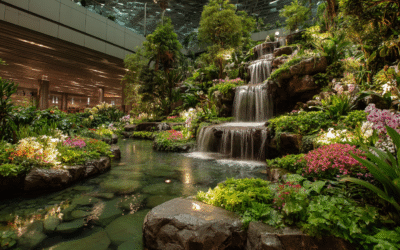There’s a peculiar emptiness that haunts certain luxury hotels. Not the intentional stillness of a Japanese ryokan or the reverent hush of a hidden spa, but something closer to amnesia—like walking into a theater after the performance has ended. Everything gleams but nothing speaks. The orchids are fresh, the linens immaculate, the marble polished to a spectral shine. And yet… the experience leaves no imprint. No trace. A kind of curated forgetfulness wrapped in 800-thread-count Egyptian cotton.
Ask guests what they recall a month later, and they struggle. “It was nice,” they’ll say. “The service was excellent.” But they won’t tell a story. There’s no emotional thread to pull, no moment that cracked them open a little.
Herein lies our modern crisis of luxury.
The Hollow Performance of Status
The version of luxury built on status symbols, square footage, and choreographed service increasingly rings hollow. It performs sophistication without intimacy. It delivers comfort without care. And in doing so, it fundamentally misunderstands what today’s discerning traveler actually craves.
Because here’s what guests truly remember:
- The barista who wrote their child’s name in chocolate on a cappuccino
- The scent of orange blossoms in the courtyard where they had breakfast each morning
- The local poem left on their pillow, translated into their native language
- The unprompted playlist waiting in their room—songs they’d mentioned in passing during booking
None of these things cost much. But they carry something far more valuable: emotional weight. They make the guest feel seen, not merely managed. Cared for, not calculated. Not just accommodated, but known.
This is the quiet revolution reshaping high-end hospitality today—a shift away from grandeur toward resonance, from status to story, from marble to meaning. We might call it emotional luxury: a design philosophy that prizes care over cost and connection over spectacle. It’s not about how much the experience is worth on paper, but how deeply it’s felt and how long it lingers in memory.
This isn’t soft thinking; it’s strategically sharp. Because emotional moments are precisely what people share, review, remember, and return for. In a saturated market of sameness, sentiment becomes the differentiator. And in a future where AI can automate almost everything, what can’t be commodified is the feeling of being genuinely, humanly considered.
The Economics of Memory
In the economics of memory, emotion remains the only lasting currency.
It’s not the thread count or the square footage that guests discuss months later. It’s the feeling of being surprised. The sense that someone cared enough to notice a detail they didn’t think anyone would catch. That they mattered.
This isn’t poetic—it’s measurable.
Behavioral science has been telling us for decades what luxury marketing only recently began to suspect: people don’t evaluate experiences rationally—they remember how they felt. And more specifically, how they felt at the peak, and how they felt at the end.
Daniel Kahneman and Barbara Fredrickson’s research on the Peak-End Rule shows that our memory of an experience is shaped almost entirely by its emotional climax and conclusion. The cumulative quality—how good it was overall—has surprisingly little effect. This means a hotel stay filled with invisible excellence (polished marble, faultless logistics, even gourmet food) can still evaporate from memory if it lacks a meaningful emotional arc.
Another crucial insight comes from affective forecasting—the psychological concept that we’re often terrible at predicting what will make us happy. Travelers book based on how they imagine they’ll feel (“pampered, seen, special”)—but real satisfaction depends on whether that imagined feeling materializes. Generic luxury often misses the mark because it doesn’t connect deeply enough to the guest’s inner narrative.
A 2023 Deloitte report confirms this shift: luxury consumers increasingly prioritize “personalization, emotional connection, and brand values” over material indicators like status or prestige. In other words, meaning is the new luxury.
This trend isn’t confined to psychology journals or consulting decks. It’s playing out in real-time across platforms like Airbnb, where guests are 20-25% more likely to leave five-star reviews when they experience personalized gestures—handwritten notes, local food, even book recommendations. These emotionally intelligent touches often come from hosts without formal hospitality training, who simply lead with genuine care.
In the high-end space, brands like Six Senses now prioritize guest wellness and emotional resonance over excess. Guests receive personalized sleep consultations, curated sensory rituals, and scent memory keepsakes. It’s luxury designed not just to impress—but to be felt.
As luxury itself becomes democratized (via loyalty programs, credit card perks, and flash deals), the truly elevated experience is no longer defined by what you get—it’s defined by how you’re made to feel. Skift’s 2024 report notes that “emotional intelligence is now a baseline skill for future-facing hospitality teams”—not a nice-to-have, but a competitive necessity.
The new differentiators aren’t:
- the number of spa treatments
- the quality of the fixtures
- the exoticness of the menu
But rather:
- the emotional literacy of the staff
- the symbolic resonance of the design
- the narrative coherence of the guest’s journey
Luxury has become a theater of feeling. And those who can’t script emotion into their offerings are watching from the wings.
The Five Emotional Anchors of Memorable Stays
If high-end hospitality is moving beyond opulence and into emotional territory, we need a new design grammar—one that helps craft experiences that are not just luxurious, but meaningful.
These aren’t service hacks or UX tweaks. They’re deeper, almost archetypal structures that shape how we form emotional connections—with places, with people, and with moments.
Across interviews, case studies, guest reviews, and behavioral research, five emotional anchors consistently appear in the most memorable stays:
1. Recognition: Being seen, not just served
There’s a world of difference between being welcomed and being recognized. A smile from someone who remembers your name, a note that references your last stay, a staff member who recalls your favorite drink—these are not just pleasantries. They’re signals of significance.
Recognition affirms identity. It tells the guest: You matter. You’re not just a reservation number.
The psychology here runs deep: we’re wired for social validation. In one study, guests reported a 40% higher sense of “belonging” when addressed by name and offered services reflecting known preferences.
The Rosewood Hotel Group excels here, training staff to recall guest preferences across properties globally—creating continuity that feels uncanny, almost familial. A boutique hotel in Lisbon sends returning guests a digital “memory scroll” of highlights from their last visit. These aren’t just nice touches—they’re recognition engines.
2. Ritual: Creating meaning through repetition and rhythm
Humans crave ritual. Even secular rituals—like being greeted with a warm towel and tea upon arrival—create a sense of safety, grounding, and presence. Rituals transform services into symbolic experiences. They make space for meaning.
This is where traditional hospitality cultures shine. In Japanese ryokans, the ritual of removing shoes, being led to a tatami room, and receiving matcha isn’t just checking in—it’s stepping into another way of being.
Some innovative properties have created new rituals: a sunset “gratitude toast” on terraces, inviting guests to pause and reflect; or a farewell candle-lighting ceremony for departing guests at wellness resorts. These aren’t just activities—they’re punctuation marks in the emotional narrative of a stay.
3. Surprise: Micro-moments of unexpected delight
Surprise is what breaks the script. It disarms expectation and spikes dopamine—the brain’s pleasure and memory chemical.
Not every surprise needs to be dramatic. A handwritten poem. A child’s drawing turned into a framed keepsake. A dessert shaped like a local legend. These emotional microbursts often cost almost nothing but stick harder than any comp’d upgrade.
A hotel in Patagonia leaves personalized field journals in guest backpacks, referencing their itinerary and weather forecast. A Tuscan farmhouse harvests guests’ names into the dough of their welcome focaccia. These aren’t expensive gestures—they’re emotional plot twists.
4. Co-Creation: Letting guests help shape the experience
People value what they help create. This is the heart of the IKEA effect, and it applies beautifully to hospitality. When guests contribute—even in small ways—they invest emotionally in the outcome.
This doesn’t mean forcing participation. It means creating low-friction opportunities for personalization. Not “we made this for you,” but “we made this with you.”
A Greek island hotel lets guests choose from locally-sourced soaps to be placed in their room. A desert camp in Jordan invites guests to build their own mezze platter under the stars—with the chef’s guidance. The power lies in ownership. A stay becomes not something received, but something lived.
5. Storytelling: Turning the stay into a coherent narrative
Our brains crave narrative. Stories help us organize experience, assign meaning, and critically—share those moments with others.
Smart hospitality doesn’t just deliver an experience. It frames it. From the way a room is introduced, to the meaning behind a spa ritual, to the backstory of the chef’s grandmother’s recipe—each element becomes part of a story the guest can tell.
Hotel Marques de Riscal in Spain gives each guest a hand-illustrated “wine map” of their tasting journey, with personal notes from each sommelier. At the Fogo Island Inn in Newfoundland, guests are paired with community hosts whose job is to narrate the island’s culture—not perform, just connect.
What matters is that guests leave with a story that feels like theirs. Not a brand’s. Not a brochure’s. Theirs.
The Masters of Emotional Design
The most emotionally intelligent hospitality brands aren’t necessarily the most famous. They’re the ones that understand a quiet truth: luxury is not something you show—it’s something you feel.
Consider Aman Resorts, which has built its reputation on what we might call emotional minimalism. With properties across Asia, Europe, and the Americas, Aman doesn’t just sell privacy—it sells presence. Rooms are understated. Public spaces whisper rather than dazzle. Staff are nearly invisible—but always available.
This isn’t cold minimalism. It’s a carefully engineered emotional environment where everything is designed to reduce cognitive friction and create space for emotional spaciousness. Guests are never greeted with “Check-in is at 3pm”—they’re welcomed whenever they arrive. Staff memorize names and preferences but rarely speak unless spoken to, reducing social pressure. Music is replaced with natural soundscapes; lighting mimics sunrise and sunset rhythms.
Aman’s genius lies not in lavishness, but in energetic subtlety. It’s a luxury of attunement. Guests consistently describe their stays as “spiritual” or “restorative”—not “opulent.” That’s emotional design at its most refined.
Or look at Japan’s traditional ryokans, which operate on an entirely different hospitality frequency. There are no lavish buffets, branded robes, or Instagrammable infinity pools. What you get is far more rare: perfectly anticipated, perfectly invisible care.
This is the ethos of omotenashi—a Japanese philosophy of hospitality that prizes pre-emptive attentiveness, unspoken empathy, and deep humility in service. Slippers turned toward the door when you return, so you step into them effortlessly. A warm towel offered before you even realize you’re cold. A breakfast presented in a layout that reflects the season and local symbolism.
There is no tipping. No fanfare. But guests leave with a kind of emotional imprint that’s hard to explain—and harder to forget. The ryokan doesn’t dazzle you; it invites you into harmony.
Designing for Emotional Luxury
So how do you actually design a stay that feels unforgettable—without relying on scale, spectacle, or spend?
It starts with a shift in intention. You stop asking, “What will impress the guest?” And start asking, “What will stay with them?” That reframe changes everything.
A practical first step is to reconsider amenities—often the most over-engineered and under-felt part of the hospitality experience. Most hotels gift guests a bottle of wine or a branded keychain. But most of these things get left behind. Why? Because they’re generic. They speak from the hotel’s identity, not the guest’s.
Now compare that to a pressed wildflower from the hiking trail the guest walked that morning, with a handwritten label: “You stepped over this at 10:12am.” Or a simple clay cup made by a local artist, with a note about who made it and what the design means. Or a jar of spice with the words: “This was in your lunch today. We thought you might want to take the flavor home.”
These are emotionally encoded objects. Souvenirs of the self rather than the space.
Next, rethink personalization. Most versions are transactional (“we saw you liked Sauvignon Blanc—here’s a bottle”). That’s fine. But the magic happens when personalization becomes symbolic. A room that contains a book by the guest’s favorite author—not requested, just remembered. A music playlist subtly playing a song mentioned during the booking process. A pillow embroidered with a phrase the guest used to describe their stay during a previous visit.
This kind of detail creates what psychologist John Bowlby would call a secure base: the guest feels known, without being surveilled. It’s not just personalization. It’s emotional attunement.
Then, anticipate, don’t just react. Service often prides itself on speed: “You asked, and we delivered.” But emotional intelligence means reading between the lines—before the request is made. In omotenashi, the greatest act of service is the one that anticipates a need the guest hasn’t yet voiced.
Finally, design symbolic closures. Most hotels over-design the arrival and under-design the farewell. But as Kahneman’s Peak-End Rule shows, guests disproportionately remember the end of an experience. That moment is a memory anchor—and a brand signature.
Instead of a rushed check-out and a printed receipt, try a simple ritual: a staff member lighting a candle or ringing a chime before the guest leaves, signaling transition. Or a poetic thank-you card with a quote tied to their journey or reason for travel. Or a personal goodbye from the staff member who interacted most with the guest.
The best closures are tiny ceremonies. They make departure feel intentional—not transactional.
The Quiet Future of Hospitality
For the past two decades, innovation in hospitality has largely followed the logic of convenience and control: faster check-ins, smarter rooms, more choices. But the future of high-end travel will be led not by more features—but by deeper feelings.
Why? Because as automation expands, human nuance becomes rarer—and therefore, more valuable. In a world of seamless efficiency, what stands out is not speed, but sensation. The real luxury will be found not in having everything—but in feeling something.
So what does the future luxury guest ask for?
Not: How big is the room? But: Do I feel at home in it?
Not: Is there a Michelin star? But: Was the meal made with care, by someone who wanted me to feel nourished?
Not: Can I control everything with an app? But: Is anyone noticing how I’m actually doing?
As hospitality evolves, the winners won’t be those with the flashiest tech or the glossiest aesthetics. They’ll be the ones who notice the unnoticed, design for the unspoken, and create stays that guests carry long after their luggage is unpacked.
Luxury has always been about differentiation. But for decades, that differentiation relied on more: more space, more polish, more exclusivity. It was a vertical game—who could go higher, louder, richer.
That game has changed. In a world where the mechanics of luxury are increasingly commoditized—where even mid-tier brands can offer thread counts, rainforest showers, and marble foyers—the real frontier is horizontal. It’s depth, not height. Feeling, not flash.
And here lies the beautiful irony: many of the most powerful emotional design elements—ritual, recognition, story, care—are cheaper, simpler, and more human than the amenities they replace.
So the real question for hospitality leaders isn’t: How do we innovate more?
But rather: How do we feel more? How do we design for warmth in a cold, efficient world? How do we create moments that say, “This was made for you”? How do we build places that stay with people—not just in reviews, but in memory?
Because in the end, people don’t return to places.
They return to how those places made them feel.
And in that truth lies not just the soul of hospitality—but its most future-proof strategy.



